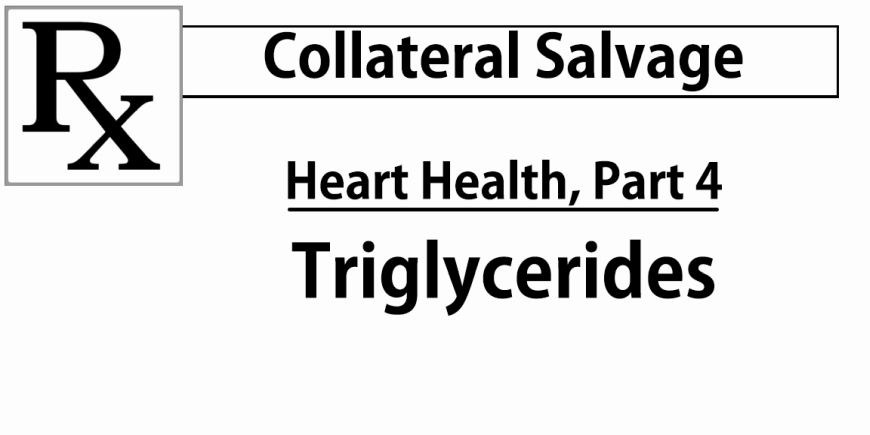More and more, it’s common to read about the dangers of triglycerides and how they are going to lead us to an early death. But why the hype? What’s their connection to cardiovascular disease (CVD)? And what is a triglyceride anyway?
First, science.
Speaking broadly, triglycerides are fats. They are how fats enter our body. All that fat that we’re trying to get rid of? Triglycerides. But they aren’t inherently bad. I talked about fats briefly in my cholesterol article, but we’re going to take a closer look at triglycerides today.

Triglycerides are made up of a glycerol molecule bound to three fatty acid chains. These fatty acids can be a mix of any type of fatty acid, saturated or unsaturated. Triglycerides that contain only saturated fats have higher melting points and are usually solids at room temperature. Butter is a good example of this, being composed of over 50% saturated fats. Oils tend to be made of mixed triglycerides.
When we consume triglycerides, they pass through our stomach unchanged. When they enter the first section of our small intestines (duodenum) the gallbladder releases bile to emulsify large groups of triglycerides into smaller groups. The pancreas releases an enzyme called lipase that chemically breaks down the triglycerides into their fatty acid components before passing into the intestine.

Once in the intestines, the fatty acids are absorbed by specialized cells that line intestinal walls called enterocytes. Triglycerides can’t be absorbed by the intestine, so here they are rebuilt where they are packed into lipoproteins known as chylomicrons along with cholesterol and protein. These chylomicrons then pass through the lymphatic system to the heart where they enter the circulatory system to be used by cells throughout the body.
Alternatively, triglycerides can be produced by the liver. Our bodies break down carbohydrates into simple sugars which our liver can use to synthesize a variety of things. When the liver releases triglycerides into the body, it does so directly into the circulatory system in the form of very low-density lipoproteins (VLDLs).
As these triglycerides circulate through the body, they will be absorbed by different tissues along the way. If they aren’t needed for energy production, they will be stored as fat.
So what’s the problem?
There is no concrete link between triglycerides and CVD. There is however a correlation between triglycerides and CVD. There’s also an inverse relationship between high-density lipoproteins (HDLs) and triglycerides, the higher our triglyceride level, the lower our HDL level tends to be, and low HDL is another indicator of CVD. Scientists have proposed a link between the onset of atherosclerosis with chylomicron remnants (what’s left of the molecule after its triglycerides have been distributed) since the 1970s.
Although the mechanism is unknown, there is a connection between high levels of triglycerides and pancreatitis. It is believed that either an excess of chylomicrons clogs the pathways to the pancreas, strangling it, or that an excess of free fatty acids directly damage it. Either way, this leads to a negative feedback loop: the pancreas regulates how we process triglycerides, if it is damaged, our triglyceride levels go up, causing more damage to our pancreas.
What can we do?
If you’ve been reading Collateral Salvage up to now, you probably know the answer: diet and exercise. All of the food choices we’ve talked about up to now are recommended to lower triglyceride levels.

Exercise is especially important because triglycerides are stored when they aren’t used. They are stored in other stores of fat, around cardiac muscles, and around skeletal muscles. Exercising ensures that we have more places to consume triglycerides, and when we store them as fat, not as much is stored around our cardiac musculature.
Ultimately, managing our triglyceride levels, like heart health in general, means making changes to our lifestyle.

Thanks for breaking this down in a way that’s easy to understand.